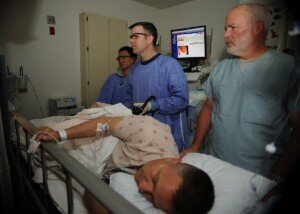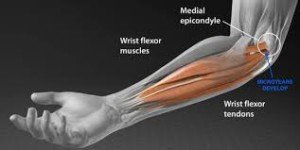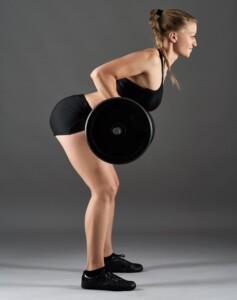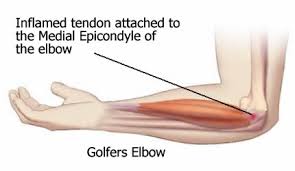Can a CT Scan Detect Colon Cancer?

If you have colon cancer, would a CT scan show it?
“CT scans are adept at locating pathology IN the abdomen or outside of the bowel,” says Sander R. Binderow, MD, FACS, FASCRS, with Atlanta Colon & Rectal Surgery.
Dr. Binderow continues, “CT is very good for solid organ disease — liver, spleen, kidneys. It can show metastatic colon cancer that has spread to the liver.
“Colon cancer, however, starts inside of the bowel. CT is notoriously unreliable for polyps or early stage tumors. It can show large, more advanced cancers or masses.”
So for instance, my father went to the ER complaining of significant lower abdominal pain and a persistent feeling of constipation.
The doctor ordered a CT scan and at some point, she commented that it would be good news if the scan did not show an “obstruction,” as this could possibly be a malignant mass — having originated as colon cancer but having infiltrated outside of the colon where a CT scan would pick it up. (Turned out my father had diverticulitis.)
And even if a mass does indeed show up on a CT scan…this doesn’t mean it’s malignant.
Dr. Binderow explains, “If a CT is suspicious for a colorectal cancer, the next immediate step would be a colonoscopy — which again is the best test to evaluate the colon and find colon cancer.”

Colonoscopy
In the absence of a CT scan, if you’re just wondering about colon cancer and would like to get some initial screening for it, you may consider Cologuard, which is a non-invasive screening test for this disease.

Cologuard kit
Cologuard uses the latest advances in stool DNA technology — detecting the altered DNA from abnormal cells in a stool sample which could be associated with cancer or precancer.
Symptoms of Colon Cancer
Symptoms of this disease are as follows: After having a bowel movement, you feel as though the movement was incomplete and that there’s still more to void — but nothing more is eventually voided.
Unexplained constipation — struggling and straining to void, despite increased fiber and water intake and even the use of stool softeners.
Unexplained diarrhea is another sign. The diarrhea may alternate with the constipation.
Stools that are shaped like ribbons or pencils.
Blood in your feces. This can present as red or maroon stools, as well as tar-black stools.
Abdominal or back pain, or unexplained loss of body weight.
The above symptoms can also have benign causes such as irritable bowel syndrome (except for the blood) and Crohn’s disease.
Crohn’s disease can actually be detected by a CT scan, but remember, colon cancer cannot.
 Dr. Binderow performs minimally invasive, robotic and laparoscopic surgery for Crohn’s disease, ulcerative colitis, colon cancer and other colorectal conditions. Adept at routine procedures, he also sees patients with complex, atypical maladies.
Dr. Binderow performs minimally invasive, robotic and laparoscopic surgery for Crohn’s disease, ulcerative colitis, colon cancer and other colorectal conditions. Adept at routine procedures, he also sees patients with complex, atypical maladies.
 Lorra Garrick has been covering medical, fitness and cybersecurity topics for many years, having written thousands of articles for print magazines and websites, including as a ghostwriter. She is also a former ACE-certified personal trainer.
Lorra Garrick has been covering medical, fitness and cybersecurity topics for many years, having written thousands of articles for print magazines and websites, including as a ghostwriter. She is also a former ACE-certified personal trainer.
.
Top image: Shutterstock/Tyler Olson
Colon Cancer Diarrhea vs. IBS Diarrhea: Is There a Difference?
Hemorrhoid Blood vs. Colon Cancer Blood: Is There a Difference?
Cure Golfer’s Elbow with Two Simple Exercises

Here is how I cured stubborn golfer’s elbow: just two exercises.
I had golfer’s elbow for many months and months that didn’t respond well to rest, avoidance of offending activities or massage.
“Golfer’s elbow is layman’s terms for medial epicondylitis, which refers to pain and inflammation of the common flexor tendon of the forearm where it inserts on the inner portion of your elbow,” says Dr. Logan Thomas, a physical therapist in Parker City, IN.
I cured my golfer’s elbow with the following two exercises: the farmer’s walk and the deadlift.
My golfer’s elbow was such that if I deadlifted only 60 pounds, I could feel the aggravation in the tendon. So I started at 40 pounds—which felt “clean.”
I began farmer’s walks with just 10 pound dumbbells, because at 15 pounds, I kind of began “feeling it.”
The Deadlift
Before employing the deadlift for your therapy, make sure your form is PERFECT. Practice with a light bar or even a wooden pole.

The deadlift. Shutterstock/Vladimir Sukhachev
Once you know exactly what you’re doing, then find the amount of weight that enables you to do eight repetitions without feeling any hint of the golfer’s elbow—none of it even tapping on your door, so to speak.
Yet at the same time, this weight should be close to that threshold in which you would begin feeling the tendon problem tapping at your door. If you can “feel it” at all, reduce the amount of weight!
Do five sets, eight reps, with two minutes of rest in between.
And during the course of this therapy, you must avoid all offending activities, whether it’s golf, certain weightlifting exercises, certain household tasks, yardwork and what-have-you.
Do the deadlifting twice a week, with three days separating each session. Every few weeks, add 10 pounds.
If the golfer’s elbow taps at your door, back down on the weight load — go back to what you’ve been doing. Never increase by more than 10 pounds.
As you can see, at this rate, it will be a LONG time before you’re deadlifting 135 pounds. Do not let this discourage you.
When I had realized I had golfer’s elbow, I could not deadlift 60 pounds without “feeling” this damage.
However, as a result of sticking to this careful program that requires a lot of patience, I was eventually pulling 225 pounds for eight reps WITHOUT feeling any hint of the golfer’s elbow.
I’ll admit, it had seemed like forever that I was using a barbell of less than 95 pounds, but I’m sure glad I just stuck it all out.
I increased the rest time to three minutes once I got over 100 pounds.
Farmer’s Walks
Because 10 pounds in each hand is so light for this exercise, I did it nearly every day.
Once I got up to a 25 pound dumbbell in each hand, I reduced it to three times a week.

The farmer’s walk. Shutterstock/DisobeyArt
Simply walk for about two minutes. If you can “feel” the golfer’s elbow, use lighter weights.
Increase the dumbbell weight no more frequently than once a week, and do so with two and a half pound increments.
I went from 10 to 12 to 15 to 17 to 20 to 22.5 to 25.
It took a long time to get up to 25, because — and I can’t say this enough — you must use a weight load that’s below the threshold, but close to it.
Eventually I was carrying a 70 pound dumbbell in each hand without feeling the slightest hint of the golfer’s elbow.
Ancillary Exercises for Curing Golfer’s Elbow

Don’t rely on just the deadlift and farmer’s walk once you begin feeling the injury really improving.
At some point, you’ll want to reintroduce other offending exercises, such as the lat pull-down and the seated cable row.
START LIGHT. If you’re deadlifting 135 for reps, don’t assume you can just jump into a 100 pound seated cable row or 135 pound lat pull-down.
The motions of these two new exercises involve a different pattern of muscle recruitment, and thus, even if you can deadlift 150, a lat pull-down of only 75 might aggravate your golfer’s elbow.
Do not use a wide grip on the lat pull-down. Use a medium overhand and underhand grip with the long bar, as well as using a V attachment.
Apply the same principle outlined earlier: Work below the threshold, and very, very gradually increase weight — and I mean gradually. Do eight reps, five sets, a few minutes in between sets.
For the cable row, use a V attachment and apply the same principle.
Be patient and your golfer’s elbow will likely be cured. If over time, there’s no improvement, then you’ll want to seek professional intervention.
 Dr. Thomas a physical therapist, and strength and conditioning coach who is passionate about patient education. He believes the most important and often overlooked step in the process to becoming pain-free is understanding the anatomy and biomechanics of your body.
Dr. Thomas a physical therapist, and strength and conditioning coach who is passionate about patient education. He believes the most important and often overlooked step in the process to becoming pain-free is understanding the anatomy and biomechanics of your body.
 Lorra Garrick is a former personal trainer certified through the American Council on Exercise. At Bally Total Fitness she trained women and men of all ages for fat loss, muscle building, fitness and improved health.
Lorra Garrick is a former personal trainer certified through the American Council on Exercise. At Bally Total Fitness she trained women and men of all ages for fat loss, muscle building, fitness and improved health.
.
Top image: Shutterstock/wutzkohphoto
Can Microscopic Colitis Spontaneously Go Away?

If you’ve been diagnosed with microscopic colitis, you’re no doubt wondering if this inflammatory bowel condition can go away on its own, or spontaneously resolve.
After all, half of all cases of microscopic colitis present with sudden onset diarrhea; diarrhea is the hallmark symptom of this benign condition.
I was diagnosed with microscopic colitis some years ago, not long after a bout of sudden-onset, watery diarrhea that didn’t seem to want to go away.
Diagnosis of microscopic colitis is confirmed with a tissue sample of the large colon, obtained via colonoscopy, and then examined under a microscope, hence the name “microscopic colitis.”
My gastroenterologist told me that the condition would “resolve on its own in a few weeks.”
Less than three weeks after the diarrhea and changed stool appearance began, I started noticing that my stools began looking less abnormal, and that the diarrhea was less frequent. I attributed this to consumption of a probiotic, kefir.
I also speculated that I had had the microscopic colitis for quite a while and never knew it (this is possible, as the symptoms of a very mild case can be masked by a high fiber diet, since a high fiber diet can cause near-daily and even daily bouts of diarrhea, and I had had a high fiber diet).
However, enormous anxiety, triggered over the diagnosis of a brain tumor in my parents’ beloved dog, was the suspect in what triggered the flare-up of the pre-existing, low-grade microscopic colitis — if that’s indeed what I had had all along.
I just can’t believe this was a coincidence; the anxiety and stress (I loved that dog!) was horrendous.
This included battles with my mother and brother over how to properly feed the dog during his alternative treatment, and sleepless nights as I lie awake in my parents’ house, heart racing as I dreaded hearing the tell-tale sounds of yet another seizure.
(I was taking care of the dog because my parents, let’s just say, weren’t exactly a prime choice for this, which included frequent injections.)
My gastroenterologist’s nurse, prior to my colonoscopy, told me he had diarrhea for two weeks as a result of his divorce.
Diarrhea doesn’t necessarily mean microscopic colitis, and again, microscopic colitis must be confirmed via large-colon tissue biopsy.
In the few weeks following my colonoscopy (which was a few days after the dog was euthanized), my symptoms diminished and everything returned to normal.
And I kept drinking the probiotic. (I had moved back home a few days after the colonoscopy.)
However, I stopped drinking the probiotic when I moved into my parents’ home again to help take care of my father after his back surgery.
Seven days after his back surgery, I took my mother into the emergency room for shortness of breath and vomiting; she was discharged with a diagnosis of gastroesophageal reflux disease (GERD).
Two days later she was back with chest pain, and was admitted to the hospital because a blood test showed a slight elevation of the heart-attack marker troponin.
The next day she underwent a quintuple bypass surgery with mitral valve replacement after an angiogram showed extensive coronary blockage.
And if the stress from suddenly being told your mother will be undergoing a 7-hour surgery because a heart attack was imminent isn’t enough, then imagine the stress of what happens after coronary bypass surgery: the possibilities of complications and the arduous recovery process.
Did all this stress bring back my microscopic colitis?
I had one bout of diarrhea, but nothing else out of the ordinary. And I continued not drinking the probiotic.
The emotional stress was unspeakable, as there were bumps along the post-operative road, and my father’s back surgery didn’t seem to have resolved his problems.
Over the weeks following my mother’s coronary bypass surgery and all the stress it brought me, my microscopic colitis never recurred.
Seems as though the microscopic colitis spontaneously went away, so far away that even this new era of stress was not able to resurrect it.
So perhaps my doctor was right when he said that the microscopic colitis would “resolve on its own.”
However, many people with microscopic colitis who post in online forums report that the condition is ongoing, chronic, and for many patients, there is no truly effective treatment.
For some individuals, microscopic colitis is more than just an annoyance.
Episodes of diarrhea can be numerous throughout the day, immediately follow meals, and the condition can also be accompanied by abdominal cramps or pain.
So, can microscopic colitis go away on its own? Can it spontaneously resolve? In at least one case, yes. In other cases, it can be chronic.
 Lorra Garrick has been covering medical, fitness and cybersecurity topics for many years, having written thousands of articles for print magazines and websites, including as a ghostwriter. She’s also a former ACE-certified personal trainer.
Lorra Garrick has been covering medical, fitness and cybersecurity topics for many years, having written thousands of articles for print magazines and websites, including as a ghostwriter. She’s also a former ACE-certified personal trainer.
.
Top image: ©Lorra Garrick
How to Cure Feeling Old from Menopause

There is ONE thing that women in menopause can do to cure the feeling of “getting old” as a result of this change in life.
Hey, I just don’t know how a woman can feel old due to menopause when she can step into a gym and deadlift 225 pounds for reps.
Now — that amount of weight may seem as far from you as the moon is, but I can say the same thing about deadlifting 135 pounds:
How can menopause make a woman who can deadlift 135 feel old?
The deadlift is one of the most effective strength training moves, regardless of one’s goal.
It’s fantastic for fat loss, shrinking the stomach, toning the legs and arms, strengthening the back, curing certain kinds of back pain, improving overall neuromuscular function and so much more.

Deadlift. Freepik.com

Freepik.com
So how does this relate to feeling old from menopause?
The thing about this multi-joint or compound exercise is that it enables you to lift a LOT of weight as you progress over time.
Not only that, but it does NOT require balancing or other movements that can put a self-conscious woman on edge — such as trying to steady oneself on a balance board or coordinate pushing dumbbells overhead while stepping onto a bench and sticking out the other leg.
The deadlift is as basic as can be. ANYONE CAN DO IT — barring those with spinal structural problems (ask your doctor about the deadlift if you’ve been diagnosed with spinal stenosis or some other vertebral issue).
It’s not like the pushup, in which women struggle and become discouraged, or the pull-up, where women rely on spotters to help them up and then feel defeated.
ANY WOMAN CAN DEADLIFT
But don’t let the simplicity of this exercise fool you. It’s one of the most effective exercises for crushing calories, improving fitness, strengthening the back and knees and improving the ability to do other exercises.
Because the deadlift involves simply that of picking a barbell off the floor and then straightening, then lowering it with control, the potential to pick up impressive amounts of weight is very real — even if menopause has you feeling downtrodden and “old.”
The ability to pick something very heavy off the floor simply contradicts that of feeling old — even if you’re suffering from other symptoms of menopause such as thinning hair, hot flashes and fat gain.
There’s just something magical about knowing you can hoist heavy objects off the floor that makes you feel YOUNG and VIBRANT, not old and haggard.
Deadlifting heavy amounts of weight has the startling ability to carry over to everyday tasks of daily living.
- Picking up and carrying babies, even heavier preschoolers, will no longer be tiring.
- Housework and yardwork will be a breeze.
- Helping someone move will no longer make you ache the next day. Nor will shoveling snow.
The best cure for feeling old from menopause is to become proficient with the deadlift.
Start out with a light bar and do not get discouraged if your wrists, forearms, legs or low back ache the next day.
Should you use gloves?
Don’t use gloves; they’ll cheat you of developing maximal grip strength. They’re a crutch and won’t allow your hands and forearms to achieve optimal strength for real-life situations.
MASTER CORRECT FORM FIRST.

Freepik.com
There are different ways to deadlift—too much information to go into for this article — but the bottom line is that you will find out what style works best for you.
However, it’s a universal phenomenon that the “mixed grip” makes handling the barbell more efficient for anybody, so you’ll want to get used to that:
One hand is an overhand grip, and the other is an underhand.
I’ll say it again: It’s impossible to feel old when you know you can lift heavy things off the floor.
 Lorra Garrick is a former personal trainer certified through the American Council on Exercise. At Bally Total Fitness she trained women and men of all ages for fat loss, muscle building, fitness and improved health.
Lorra Garrick is a former personal trainer certified through the American Council on Exercise. At Bally Total Fitness she trained women and men of all ages for fat loss, muscle building, fitness and improved health.
Caregivers to Elderly: How to Lift Mother off the Floor

When I was a caregiver to my elderly mother, I was always easily lifting her 130-pound body off the floor.
Following quintuple bypass surgery, mitral valve replacement and a pacemaker implant, my mother developed a mysterious condition that disrupted her blood pressure and/or blood vessels (none of the doctors had an answer).
This condition caused her brain to gradually begin losing oxygen (blood flow) whenever she exited a chair (or bed) to be on her feet.
Within seconds to about two minutes, she’d begin passing out, but the passing out was gradual, rather than the sudden fainting that “drops” someone in an instant.
Because it was gradual, there was time for cognitive changes to manifest over the seconds to few minutes, stripping her of insight into what was happening.
This was combined with general non-compliance (refusing to alert me every time she exited a chair).
As a result, I couldn’t let her out of my sight or else she’d ultimately lose consciousness and fall—risking catastrophic head injury. I had to walk right behind her.
The gradual passing out was inevitable, and my mother, becoming increasingly disoriented and belligerent (from the oxygen deprivation to her brain), would eventually show signs of imminent loss of consciousness.
At this moment, I’d place my arms snug under her armpits, as I was always behind her during these incidents.
The junction of my upper and lower arms was up against her armpits. Feet about shoulder width apart, I’d then “sink” her butt to the floor (keeping my low back arched and dropping into a half squat).
At this point she was out of it, unable to contribute to the “sinking.”
Often, this bizarre malady caused her legs to stiffen, so instead of her legs bending as I “sunk” her, they remained rather straight and stiff as I placed her on her butt. If we were in crowded corners, this was tricky.
If you’re wondering why I didn’t just hold her upright till the spell passed, it’s because these slow-motion orthostatic hypotensive episodes were determined to run their course.
Had I held her upright, she would have completely lost consciousness, and I’d have to then sink her anyways. Why wait till complete loss of consciousness?
Sinking my mother to the floor had to be done gently and with control…the way a weightlifter controls the lowering of a barbell.

Shutterstock/Everyonephoto Studio
Once she was on the floor, she’d regain her wits, but was too weak to get up on her own. I had to lift her back up to her feet.
In case you’re wondering why I didn’t just sink her into a chair instead of the floor, this is because her mental state was too altered to respond to a directive to sit in a chair—her mental faculties were impeded.
Due to the stiff, unbending legs, getting her butt square into a chair was difficult. I’d actually tried this initially, but had trouble aiming her butt into the nearest chair, so I decided, why not just sink her to the floor—wherever we were when one of these episodes occurred.
They occurred outdoors frequently when she got out of the car. I’d sink her on grass, cement and inside stores, then lift her back up.
As a caregiver, how did I easily lift my elderly mother from the floor?
She’d be sitting on the floor, back and head resting against my legs for some moments while the blood was restored to her brain.
But despite regaining her wits, she was too weak to get up, so I’d position my arms under her armpits and be in a position that resembled a fusion of the start of a deadlift motion (see photo above) and a half squat.
My legs and glutes powered me up, but so did my middle and lower back, though the lower back contributed only in terms of stabilizing my spine rather than force production.
I kept an arch in my lower back, making sure my back did not round, and simply straighted up, like performing a barbell “back” squat and deadlift hybrid.
Once my mother was on her feet, she could be up on them as long as she liked; the orthostatic hypotension would occur only one time after every time she rose from a seat.
I just described technique, but what about the strength to lift an elderly person from the floor without much effort?
I did this all day long and in the middle of the night, and once found myself straddling the toilet, my back facing the wall, my mother sitting on the seat in front of me, after she began passing out while on the seat (the result of exiting a chair to use the bathroom; I had followed her, anticipating the slow-motion passing out).
I never knew when I’d have to sink her and then lift her off the floor, but I was always physically prepared.
Effortless lifting of an elderly person off the floor will come to anyone who’s been training heavy with weights for a good amount of time.
Though 130 pounds doesn’t seem like much, this is entirely too heavy for most female caregivers, and even some men would struggle with this—possibly straining their back in the process and/or experiencing exhaustion.
I felt I could lift her off the floor even if she weighed 150, because my body had pre-existing training with the deadlift.

Shutterstock/sportpoint
“The sumo deadlift [above] would be THE exercise I would recommend to caregivers to be prepared for situations that would require the possibility of getting someone off of the floor,” says Dr. Chris Hardy, DO, a former Navy physician and NSCA certified strength and conditioning specialist.
“The wide stance and body mechanics of this exercise make it the most applicable and valuable for this type of situation to allow effective and safe lifting of a person from the floor.”
An alternative is the standard stance, as depicted below.

Anastase Maragos/Unsplash
If you don’t train with weights and currently are not a caregiver to an elderly mother (or father), I urge you to take up the deadlift, back squat (or dumbbell squat) and leg press—so that if one day you do become a caregiver to an elderly parent, you’ll be ready.
Go heavy and hard once you master proper form.
Additional exercises that will prepare you to lift an elderly person off the floor include the bent-over dumbbell row (shown below).

Shutterstock/Catalin Petolea
If you’re currently a caregiver to an elderly parent and don’t train with weights or have been lifting only light weights, then start lifting heavy and take up the aforementioned exercises, particularly the deadlift.

Shutterstock/The Faces
Being an lot taller than the elderly parent, whom you’re a caregiver to and trying to lift off the floor, is not a pass on training with heavy weights.
Though being taller adds a degree of biomechanical assistance—it’s pretty much worthless if your “posterior chain” muscles are out of shape (middle and lower back, butt and hamstrings).
 Dr. Hardy merges his expertise in nutrition, strength and conditioning, and in clinical/preventive medicine into a comprehensive approach to treat chronic disease.
Dr. Hardy merges his expertise in nutrition, strength and conditioning, and in clinical/preventive medicine into a comprehensive approach to treat chronic disease.
 Lorra Garrick is a former personal trainer certified through the American Council on Exercise. At Bally Total Fitness she trained women and men of all ages for fat loss, muscle building, fitness and improved health.
Lorra Garrick is a former personal trainer certified through the American Council on Exercise. At Bally Total Fitness she trained women and men of all ages for fat loss, muscle building, fitness and improved health.
Top image: Shutterstock/Cherries
5 Reasons a Woman with Broad Shoulders Should Feel Great

Women who have broad shoulders should prize their dimensions, not despise them!
Why is it that if a woman has a trait that’s “more,” she so often detests it?
I wonder if women who hate having broad shoulders, or who hate being very tall, etc., were raised to believe that it’s wrong for women to take charge in situations, voice opinions and show some feistiness and fire when push comes to shove.
I’m a woman with broad shoulders and I love them!
Though I’m not super tall, my height of 5-8 in combination with my broad shoulders creates in me a presence that can hardly be described as demure and classically feminine.
#1. They can be intimidating to a man.
WAIT — before you go, “What? That’s the problem!” let me say this: A man is less likely to mug a woman whose shoulders are as broad as his.
A rapist might think twice before “interviewing” a potential victim when he spots the broad shoulders.
To a man, this stunning trait in a woman might indicate the ability to throw a knockout punch — whether she can or can’t. It’s all about what seems to be.
#2. They can help you find Mr. Right.
Yes, that’s correct: Broad shoulders in a woman can help her quickly determine which men are put off by a trait that, quite frankly, should be seen as exceptionally attractive.

Shutterstock/eanstudio
Though many men find this trait to be sexy and appealing, it’s also true that some men do not like broad shoulders in the opposite gender.
If a man blows you off because of this trait, then this isn’t the right man for you, and you found out before you wasted six months of your life dating him (if you had “normal” shoulders).
#3. When the body gets old, it shrinks.
Look at the shoulders of elderly women. They’re atrophied, often shapeless.

Is this where your shoulders are headed? Shutterstock/wavebreakmedia
Now, if a woman does some serious strength training before she reaches senior age, she can dramatically delay and partially prevent much of the shriveling up of her upper body with old age.

Sharon Smith of Denver, CO, is 71 years young! Are her shoulders awesome or WHAT!
A woman with broad shoulders won’t look as shrunken, vulnerable and frail when she’s elderly.
Clothes will fit much better on her old body; the shoulders will be like hangers.
#4. I have to believe that this trait means that she is that much more efficient at certain sports.
I’ll admit I’ve never read any research studies on this topic, so I’m basing my assessment on common sense.
Imagine a woman with a small upper body swinging a golf club to make a 250-yard drive; throwing a softball to the first baseman from center field; attempting to whip out a Frisbee to her dog to chase after; or lifting heavy weights.
Now, imagine a woman with broad shoulders doing these same things.
Seems to me that broad shoulders would produce more torque; torque is a physics term that applies to rotary force.
#5. This next reason might seem silly…
A woman’s broad shoulders better hold up a purse strap.
I’ve seen those with tiny shoulders constantly pushing up a falling purse strap!
I’ve seen them keeping their shoulder in a hunched-up position to prevent the strap from slipping.
So such are my five reasons a woman can feel great about having broad shoulders!
Sharon Smith has been in the fitness industry for 25+ years and specializes in the over-40 client.
 Lorra Garrick is a former personal trainer certified by the American Council on Exercise. At Bally Total Fitness she trained clients of all ages for fat loss, muscle building, fitness and improved health.
Lorra Garrick is a former personal trainer certified by the American Council on Exercise. At Bally Total Fitness she trained clients of all ages for fat loss, muscle building, fitness and improved health.
Top image: Shutterstock/YAKOBCHUK VIACHESLAV
Six Myths About Dog Muzzles

Muzzling a dog has received a really bad rap, and many people even believe that putting a muzzle on a dog is cruel or inhumane.
This perception was perhaps ignited by images of greyhounds being caged and muzzled with wire contraptions.
Myth #1: The muzzle interferes with the dog’s breathing.
My parents thought this because after they removed their German shepherd’s denim muzzle while in the car, he began panting. However, look at the design of a muzzle.
The animal’s nostrils are exposed. My parents thought that breathing was compromised because the design prevented barking, i.e., opening his mouth.
Eventually my mother asked a vet if these devices cut off breathing, and the vet assured her that they do no such thing.
Myth #2: Muzzles stress a dog out.
This same vet then added, “Muzzles relax dogs and make them feel secure.”
And I have witnessed this many times with their dog; he seems most relaxed when it’s on him, and he even falls asleep with it on.
Of course, at a buzzing vet clinic, the gadget doesn’t do much to calm the dog, but that’s because at the clinic, there is sensory overload; the animal could see, hear and smell all the dogs there, plus the cats, in the waiting room.
Myth # 3: Muzzles prevent a dog from drinking.
This depends on the design of the contraption.
A mesh design, also known as a basket design, will allow drinking, if the water is high enough in a bowl.
The dog simply proceeds to drink, and pushes down into the bowl, and the water level rises through the muzzle and the animal can lap up the water.
The other common design, in which the gadget is a solid material such as denim, will not permit drinking.
Myth # 4: A muzzle doesn’t guarantee protection from getting bitten.
Again, this depends on the design. The mesh or basket type will, indeed, prevent biting.
Myth # 5: A muzzle hurts.
They do not; make sure they are not strapped on too tightly, that’s all.
Myth # 6: A dog will associate a muzzle with punishment.
You will determine this, not the muzzle.
If right after you put the device on your dog, you yell at him, strike him, lock him in a room, or subject the animal to some other aversive condition, then yes, he will associate the device with punishment.
I put one on my parents’ dog before giving him medical injections — 30 minutes before, so that he wouldn’t associate the device with needles.
A treat at the bottom of the muzzle will make the dog associate this device with getting a treat — and that’s always a happy time for a dog!
 Lorra Garrick has been covering medical, fitness and cybersecurity topics for many years, having written thousands of articles for print magazines and websites, including as a ghostwriter. She’s also a former ACE-certified personal trainer.
Lorra Garrick has been covering medical, fitness and cybersecurity topics for many years, having written thousands of articles for print magazines and websites, including as a ghostwriter. She’s also a former ACE-certified personal trainer.
NDEs Are Real: 3 More Commonalities to Near-Death Experiences

Here are 3 outstanding points that support the idea that NDEs are very real.
But first, here are the well-established common features of an NDE that point to the idea that they are very real:
Being outside one’s body and observing conversations, actions and physical appearances of people they’ve never met—that are later verified.
Returning from the NDE with knowledge that the individual could not have possibly known unless they had learned it from the deceased loved-one they encountered during the NDE.
Other common features point to the reality as well. For example, why would everyone, from any walk of life, any religion, any age, encounter some form of a blinding or brilliant light that never hurts their eyes?
- Why do so many have a life review?
- Why are the experiences so overpowering that the NDE’er’s outlook on life and attitudes towards people are profoundly altered?
And that barrier or border; nearly every NDE has this feature: some kind of threshold that the person knows that going through it will mean a point of no return.
There are three additional features that are common to all NDEs that heavily point to their reality.
Skeptics, or people who insist that near-death experiences are hallucinations or dreams manufactured by dying brain cells or brain cells starved of oxygen, really need to ask themselves the following questions:
#1. Why is it that in these alleged hallucinations or dreams…the person never actually crosses that threshold and gets into Heaven?

Freepik.com, creativeart
Nobody ever comes back to say, “I got into Heaven! There was this bridge, and I knew that if I crossed it, there’d be no going back.
“I wanted so much to cross it, and my deceased loved-ones beckoned for me, so I did—I crossed the barrier—and I was officially christened an angel!”
No sir, NDE’ers never report crossing over. They say, 100 percent of the time, that they either decided to return to their body, or, they were forced back into their body.
Funny how none have ever reported that they wanted to go back to their body, but were forced to go through that barrier or gate!
If NDEs are only a dream or hallucination, then anything should go. So why don’t NDE’ers ever actually cross over, then “wake up” from the dream to report this?
#2. Part of many NDEs is the OBE: out of body experience.
Now don’t you find it quite interesting that whenever someone reports the “hallucination” of being outside their body…that they never also “hallucinate” or “dream” that their body is doing anything more than just lying there unmoving with its eyes are closed?

Why don’t NDE’ers ever report, “I was floating above my body. I then saw my eyes open and my body sit up, and then my body walked across the room and called Dominoes to order a pizza. The pizza came seconds later and I watched my body eating it.”
Dreams during sleep, and hallucinations from brain chemistry gone awry, typically LACK logic.
So why don’t NDE’ers report that they witnessed their body get up and speak to the NDE’er?
Or order that pizza? Why doesn’t the NDE’er ever have conversations with his or her “body”? Or jump off the operating table and tell the doctors, “Hey, I’m cured!”
No sir. The body always just lies there, not moving. It never suddenly grabs the resuscitation paddles and says, “Hey Doc, enough already.” Aren’t dreams and hallucinations supposed to be rather wild?
Yet the “dream” or “hallucination” of hovering over one’s own body are quite bland: The body never does anything but lie there.
#3. If these are dreams or hallucinations…why don’t NDE’ers ever experience their fantasies?

©Lorra Garrick
For example, many people fantasize being intimate with their favorite movie star — or gorging on the best chocolate cake in the world. The one at the top of this article would be one heavenly experience!
You’d think that in these exceptionally vivid dreams or hallucinations, the dying brain cells would conjure up a very stunning replica of, say, Marilyn Monroe, Elvis Presley, Sharon Stone or Harrison Ford — there for the taking by the NDE’er — who then proceeds to spend what seems like hours with this facsimile of their favorite entertainer.
So those are the three questions that skeptics of NDEs need to ask themselves.
The overnight dreams and drug-induced or mental-illness-induced hallucinations of people do NOT contain common threads like NDEs do.
Really, if you were to ask 1,000 people what they dreamt last night, you’d get hundreds of very different stories.
Ask 1,000 NDE’ers to explain their “dream,” and you’ll get the same thing over and over and over (though the details will differ, e.g., how they approach the light, shape of the light, type of barrier, presence or absence of music, etc.).
 Lorra Garrick has been covering medical, fitness and cybersecurity topics for many years, having written thousands of articles for print magazines and websites, including as a ghostwriter. She’s also a former ACE-certified personal trainer.
Lorra Garrick has been covering medical, fitness and cybersecurity topics for many years, having written thousands of articles for print magazines and websites, including as a ghostwriter. She’s also a former ACE-certified personal trainer.
.
Top image: Shutterstock/Gts
If NDEs Are Real, Why Aren’t They All the Same?

Why do NDEs differ so much, despite the common themes?
Some commonalities among near-death experiences are that of overwhelming joy and peace; reunions with deceased loved-ones; a threshold that the NDE’er knows that once crossed, there will be no return; the absence of time; brilliant lights; and a feeling that one’s consciousness is intertwined with everyone else’s.
However, all of the details that can be filled in differ wildly from one NDE to the next.
There is no universal setting. Messages and interactions differ tremendously.
The appearance of spirits or angels differs. Why would angels or spirits look so different from one NDE to the next?
Why does God or Christ look different to different people?
And that light—that blinding light—sometimes it’s a sphere. Sometimes it’s a pillar-like shape.
One man described it as strands or strings. Sometimes it’s an orb. Sometimes the light has no shape or form; it’s just there.
Another differing aspect of the NDE is the “barrier” or threshold that the person instinctively knows that if they cross it—they won’t be able to return to their physical body.
In some NDEs it’s a bridge over some water. In one NDE that I read about on nderf.org, the barrier was a set of glass doors.
In another, the barrier was a ball of light. Sometimes it’s a walkway of sorts. Does the after-life have a lot of different barriers?
“No two near-death experiences are the same,” says Jeffrey Long, MD, author of the New York Times Best Seller, “Evidence of the Afterlife: The Science of Near-Death Experiences.” Dr. Long is a radiation oncologist in Houma, Louisiana.
Sometimes the NDE’er will spend time inside buildings or libraries and be “walking” on marble. Sometimes the NDE will involve water.
Or it may be fields of grass and flowers. Sometimes there’s music. Other features that are not common to all include panoramic vision, a life review and colors that the NDE’er cannot describe other than to say that no such colors exist in the physical world.
Interestingly, you’d think that at least some NDEs would include gorging on the most delicious foods the person has ever eaten without getting full—either the best versions of their favorite foods in the physical world, or, new tastes and gustatory experiences they’ve never had before.
After all, eating is one of life’s most intense pleasures. Oddly, eating isn’t much of a part of the NDE phenomenon.
Another NDE might have clouds. Some involve outer space, planets and galaxies. Despite the common threads, NDEs really are so different from one individual to the next.
Dr. Long continues, “My best guess as to why this is happening is that NDEs are an intersection with the infinite and eternal.
“It is quite possible that NDEs may be co-created to help the near-death experiencer learn what they need to learn to help them in their meaning earthly life.”
 As a leading NDE researcher and a medical doctor, Dr. Long has appeared on national media including NBC Today, ABC with Peter Jennings, the Dr. Oz Show, the History Channel, the Learning Channel and National Geographic.
As a leading NDE researcher and a medical doctor, Dr. Long has appeared on national media including NBC Today, ABC with Peter Jennings, the Dr. Oz Show, the History Channel, the Learning Channel and National Geographic.
 Lorra Garrick has been covering medical, fitness and cybersecurity topics for many years, having written thousands of articles for print magazines and websites, including as a ghostwriter. She’s also a former ACE-certified personal trainer.
Lorra Garrick has been covering medical, fitness and cybersecurity topics for many years, having written thousands of articles for print magazines and websites, including as a ghostwriter. She’s also a former ACE-certified personal trainer.
Where Does the Soul Go During Cryonic Suspension?

If your soul goes to the afterlife at the start of your cryonic suspension, what happens if you’re thawed out and cured of your disease?
Let’s play around with this a little. Let’s just suppose that one day, cryonic suspension of humans is possible. In cryonic suspension, a person with an incurable terminal illness would be frozen.
When the cure is discovered, the patient would then be thawed out and given the cure, and resume life — even if this thawing occurred 200 years after the freezing began.
In cryonic suspension, the body, technically, is dead (no heartbeat).
So according to this, the patient has an NDE, if you believe that everyone who experiences cardiac arrest has an NDE.
However, a cryogenically preserved body doesn’t decay or decompose, so in that sense — true death doesn’t occur. The tissues are preserved.
So where is this person’s consciousness (astral self, spirit, soul) meanwhile? Does it hover in the “vestibule” between life here on Earth and life in Heaven?
You can’t freeze a soul. You can’t freeze your astral double or spirit…so it has to go somewhere during the suspension. But where?
Maybe you’re thinking, “There’s no point in speculating because we will never achieve this kind of technology in the first place.”
But you don’t know that. Go back to the Renaissance and tell the most brilliant minds of that time that one day, there will be heart transplants.
Tell them that one day doctors will take an unborn baby halfway out of the womb, surgically repair a defect, then put the baby back in to finish up its growth.
Tell them we’ll be able to clone dogs and cats. Tell them one day man will walk on the moon.
What seems impossible even in this day and age may actually one day be a reality, so don’t be quick to dismiss the possibility of cryogenic science — the ability to freeze people and then thaw them out and revive them.
You can’t compare this to what happens to a piece of steak that’s been in your freezer for 20 years.
That steak was not treated chemically or subjected to any kind of medical applications.
However, this all still begs the question:
Where does the soul go during cryonic suspension?
Would the patient have any kind of NDE? Does the patient actually cross over into the afterlife and exist as any deceased person would, in spirit form, doing things that spirits do?
And if so, then suppose 200 years later a cure for their disease is found. Does a spirit guide — or even God — inform that person, “They’ve found a cure for your disease; you have to go back”?
I posed this question to Jeffrey Long, MD, author of the New York Times Best Seller, “Evidence of the Afterlife: The Science of Near-Death Experiences.” Dr. Long is a radiation oncologist in Houma, Louisiana.
Dr. Long explains, “This is speculative, but my guess would be that their spirit would remain in existence even if their physical consciousness is dormant.
“NDEs point to a collective consciousness. The collective consciousness seems related to spirit or ‘soul.’ I think that this would operate the same way as people who are physically unconscious for a short period of time.”
For obvious reasons, there have never been any scientific studies regarding what would happen to the soul of a person who’s in cryogenic suspension.
But this topic is utterly fascinating and can drive an all-nighter of discussions.























































